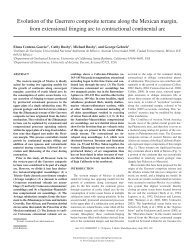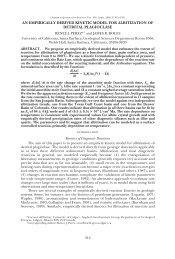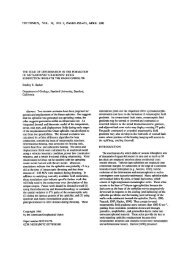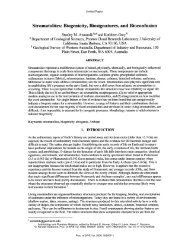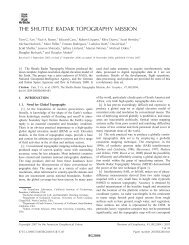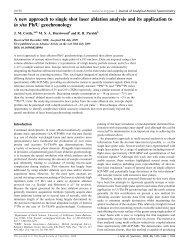Campaign-style titanite U-Pb dating by ICP - Earth Science ...
Campaign-style titanite U-Pb dating by ICP - Earth Science ...
Campaign-style titanite U-Pb dating by ICP - Earth Science ...
Create successful ePaper yourself
Turn your PDF publications into a flip-book with our unique Google optimized e-Paper software.
98 K.J. Spencer et al. / Chemical Geology 341 (2013) 84–101Fig. 11. Titanite dates (Ma) from gneiss and granulite show generally northwestward-younging Scandian dates and significant inheritance of ~1.6 Ga, possibly ~1.2 Ga, and 0.96 Gacomponents. Locations of young eclogite ages from Flatraket, Hellesylt, Hareidlandet, and Gurskøya are discussed in the text. See Fig. 9 caption for further explanation.40 Ar/ 39 Ar muscovite dates young northwestward toward the core ofthe orogen in a systematic way (Figs. 2 and 14). The U–<strong>Pb</strong> <strong>titanite</strong> datesalso generally young toward the core of the orogen (Figs. 12 and 14).One might thus imagine that the difference in 40 Ar/ 39 Ar muscovitedates and U–<strong>Pb</strong> <strong>titanite</strong> dates could be used to calculate cooling ratesacross the WGR and to develop a detailed map of times and rates ofcooling. Instead, the two types of date show considerable overlap—within uncertainty—and, in particular, there is no resolvable differencebetween the 40 Ar/ 39 Ar muscovite date and the youngest <strong>titanite</strong> date ata given locality (Fig. 14). This implies, again, that the U–<strong>Pb</strong> <strong>titanite</strong> datesare the result of (re)crystallization induced <strong>by</strong> fluid flow, deformation,or reaction, and are not the result of thermally mediated volume diffusion;the same could be true for the 40 Ar/ 39 Ar dates. In other words,each <strong>titanite</strong> date reflects the last time that the U–<strong>Pb</strong> system wasdisturbed <strong>by</strong> any process. There is a northwestward gradient in theyoungest date measured, but in many locations within the orogenthere is a range of dates reflecting crystallization or <strong>Pb</strong> loss duringfluid flow, deformation, reaction and/or volume diffusion.4.2. Flow & phase transformations in the deep crustThe surprising survival of <strong>titanite</strong> in 450–750 km 2 domains througha25–40 Myr long orogenic event at ultrahigh pressures and attemperatures as high as 750 °C requires that the <strong>titanite</strong> in these ‘olddomains’ remained metastable at those extreme conditions. The existenceof metastable <strong>titanite</strong> strongly suggests that other cogeneticphases—most specifically the low-pressure mineral plagioclase—werealso metastable at those conditions. If plagioclase and <strong>titanite</strong> survivedmetastably, it is impossible for the rock to have recrystallized extensively(i.e., flowed ductilely to high strain) at 3 GPa and 750 °C. The extensiveregion of Scandian <strong>titanite</strong> mapped out in this study (Fig. 12),correlates reasonably well with the zones of “moderate” and “strong”Scandian fabric mapped <strong>by</strong> Hacker et al. (2010) on the basis ofoutcrop-scale structures. Realizing that typical quartz-bearing rockscan reach mantle depths and then be exhumed near-isothermally at750 °C without internal deformation is important and affects our viewof tectonics, petrology, geochronology, geodynamics, geodesy and geophysics.Models that are founded simply on the assumption that rocksweaken exponentially with increasing temperature are likely wrong; itwould be more realistic to model rock strength as a function of additionalvariables such as bulk composition and volatile content. The relativelydry high-amphibolite to granulite-facies gneisses of the WGR wereclearly stronger and less reactive than lower grade, more-hydrousquartzofeldspathic rocks.4.3. Exhumation-related amphibolite-facies metamorphismThe <strong>titanite</strong> dataset described herein places useful constraints on theformation and exhumation of the WGR. 1) Titanite recrystallizationtook place over ~20 Myr at elevated temperature. 2) If the U–<strong>Pb</strong> datesfrom <strong>titanite</strong>s in Caledonian leucosomes are crystallization ages—asseems probable from the high inferred closure temperature and thesimilarity in dates from deformed and non-deformed leucosomes—local melting continued for at least 15 Myr, until ~385 Ma. The spatial



